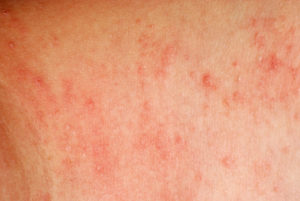
Contact Dermatitis
Definition:
Itching, redness, and/or pain caused by local inflammation triggered by direct physical contact with a foreign substance on the skin.
There are two types of Contact Dermatitis:
Irritant: This is the more common type caused by irritation of the skin caused by contact with acids, alkaline materials such as soaps and detergents, fabric softeners, solvents, or other chemicals. Rubber (latex) gloves, long exposure to wet diapers, and certain shampoos can also result in skin irritation.
Allergic: Inflammation of the skin is triggered by an allergen mediated by the immune system. Common causes are physical contact with:
- Nickel – used in jewelry, buckles, and many other items
- Medications – i.e., antibiotic creams and oral antihistamines
- Balsam of Peru – used in perfumes, cosmetics, mouth rinses, and flavorings
- Formaldehyde – used in adhesives, solvents and other items
- Personal care products – i.e., deodorants, body washes, hair dyes, cosmetics, nail polish, and herbal preparations for the skin containing eucalyptus or camphor
Some substances cause skin rashes only after exposure to sunlight (“Photosensitive contact dermatitis”). These include some sun screens, shaving creams and medications containing sulfa agents.
Certain occupations like healthcare workers, food handlers, cosmetologists, metal/construction workers, and agricultural laborers are predisposed to contact dermatitis.
Symptoms:
A few hours or days after the contact with the irritant or allergen, the skin may show
- Red rash or bumps
- Itching, which may be severe
- Dry, cracked, scaly skin, if your condition is chronic
- Blisters (which can draining fluid) and/or crusting, if your reaction is severe
- Swelling, burning, and/or tenderness
Complications:
- Chronic itchy, scaly skin – A skin condition called “neurodermatitis” (also known as “lichen simplex chronicus”) starts with a patch of itchy skin. Repeated scratching can cause discoloration and leatheriness of the skin.
- Infection – Constant scratching may cause the skin to become wet and ooze. This moist environment creates a good place for bacteria and/or fungi to grow which may lead to an infection.
Diagnosis:
The cause of the contact dermatitis can sometimes be detected by taking a thorough history of all possible contact exposures of the skin that occurred or continues to occur before the onset of the rash. A careful physical examination is also essential to make the diagnosis.
Allergy testing with skin patches (called “patch testing”) may determine what is causing the reaction. Patch testing is used for certain patients who have long-term or repeated contact dermatitis. It requires more than one visit and is done in our allergy offices as the board certified allergists at Black & Kletz Allergy have the expertise to interpret the results correctly.
- On the first visit, small patches of various allergens are applied to the skin. The test area needs to be kept dry to avoid the patches from peeling off. These patches are then removed 48 hours after the initial application.
- On the last visit, which occurs a few days after application of the patch tests, the reactions on the skin (if there is a positive reaction) are interpreted.
Prevention:
Identification of the offending agent and subsequent avoidance of the substance at all times is essential.
Treatment:
Often, treatment includes washing the area with plenty of water to get rid of any traces of the irritant that is still on the skin. Further exposure to the substance should be scrupulously avoided.
Oral antihistamines are often used to help control itching.
Emollients and/or moisturizers help keep the skin moist and aid in allowing the skin to repair itself. They also help protect the skin from becoming inflamed again. The emollients and/or moisturizers are a key part of preventing and treating contact dermatitis.
Wet dressings and soothing anti-itch (antipruritic) drying lotions may be recommended to reduce other symptoms.
Topical corticosteroids are medicines used to treat eczema and are very useful in controlling raging inflammation.
In severe cases, one may need to take an oral corticosteroid. It is usually started at a higher dose and gradually reduced and stopped over a 6 to 10-day period of time.
If you are suffering from a skin rash of any kind and/or itching of your skin, we at Black & Kletz Allergy would be happy to see you at one of our 3 convenient locations in the Washington, DC, Northern Virginia, and Maryland metro area. Please call us or click Request an Appointment and we will schedule you for an appointment with one of our board certified allergists.
